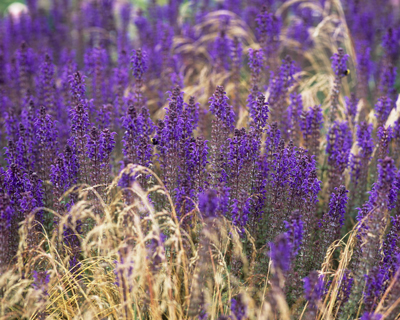10 award-winning (AGM) plants for new gardens
When you stand at your kitchen window and look out at your brand new, empty and unplanted garden – what plants should you choose?
When it comes to planning a new garden, a combination of long-term and short-term thinking is ideal, so you need two kinds of plants. Some that will mature into impressive specimens over time, even if they don’t make much impression at first, and others that will create impact almost straight away, even if you end up removing them later when they’ve done their job. And they often need to perform on poor soil that has not yet been improved. Hardy
Here’s my choice of RHS Award of Garden Merit (AGM) trees, shrubs, climbers and
The blue-flowered
Rubus ‘Benenden’ is a thornless, shrubby bramble that flowers prolifically in May, with large shimmering white flowers. Then, for the rest of the summer, it makes the ideal support for a morning glory (Ipomoea) planted in front, immediately after cutting out some of its old growth as the flowers fade. Grows well on poor soil, and quickly makes a good specimen. Height to 2m (6ft 6in). Hardiness rating H5.
Many new gardens have a damp patch. It may be natural, it may be the result of building work, but either way a perennial that fills out quickly, flowers for many weeks and can easily be removed or curtailed is exactly what’s needed. Bistorta officinalis ‘Superba’ fits the bill nicely. Stout pink spikes top the lush foliage in May and June. It spreads well, but is easy contained. 75cm (30in). Hardiness rating H7.
The yellow tree lupin, Lupinus arboreus, is a very bright and cheerful plant. It flowers when very young, quickly makes a big plant with evergreen, prettily-fingered leaves and then, having done its job for a few years, is inclined to die and leave a space for something else. The long spikes of yellow pea flowers are nicely scented. Needs sun and good drainage and is happy in poor soil. 1–1.8m (3–6ft). Hardiness rating H4.
Some gardeners still look down on privet, Ligustrum ovalifolium, but it has the great virtue of creating a colourful feature while putting up with the poor, unimproved soil, or even builders’ rubble, found in so many new gardens. Ligustrum ovalifolium ‘Aureum’ has rich golden yellow, almost evergreen, leaves with green centres from spring to autumn and beyond. It is happy in sun or partial shade. 2–3m (6ft 6in–9ft). Hardiness rating H5.
The shrubby mallows, for example Malva × clementii, are perhaps the best of all shrubs for quickly making a colourful, long season impression – and then after a few prolific years they usually fade away to leave a space for something more permanent. Malva × clementii ‘Burgundy Wine’ has deep purplish-pink flared flowers for many months over the summer. Best in full sun, prune hard in spring. 1.2–1.8m (4–6ft). Hardiness rating H5.
Plant a tree for the next decade, but plant Laburnum × watereri ‘Vossii’ for next year; it will usually flower the first year after you plant it. The unusually long – up to 60cm (2ft) – strings of brilliant yellow flowers open in June; and once it’s settled in you can plant a summer-flowering clematis to grow into it. 8m (26ft). Hardiness rating H6.
Clematis are ideal climbers for new gardens. They grow to a good height in their first year and even though early growth may be thin, the flowers will open high up and give an impression of maturity. The bronzed foliage of Clematis montana var. rubens ‘Tetrarose’ adds an unexpected dimension, and its 8cm (3in) lilac pink flowers in May and June soon come in vast numbers. 5m (16ft). Hardiness rating H4.
At the front of shady borders, or in between newly planted shrubs, a large-leaved bugle will quickly cover the ground, look good and help prevent weed growth. Ajuga reptans ‘Catlin’s Giant’ has leaves that at 15cm (6in) are larger than those of most bugles and with their bronze colouring, plus the spikes of blue spring flowers, they quickly make a bold impression but are easy to pull out when the time comes. 20cm (8in). Hardiness rating H7.
Achilleas bring us the perfect combination of pretty foliage, long-lasting flowers and a tolerance of less than ideal soil conditions.


